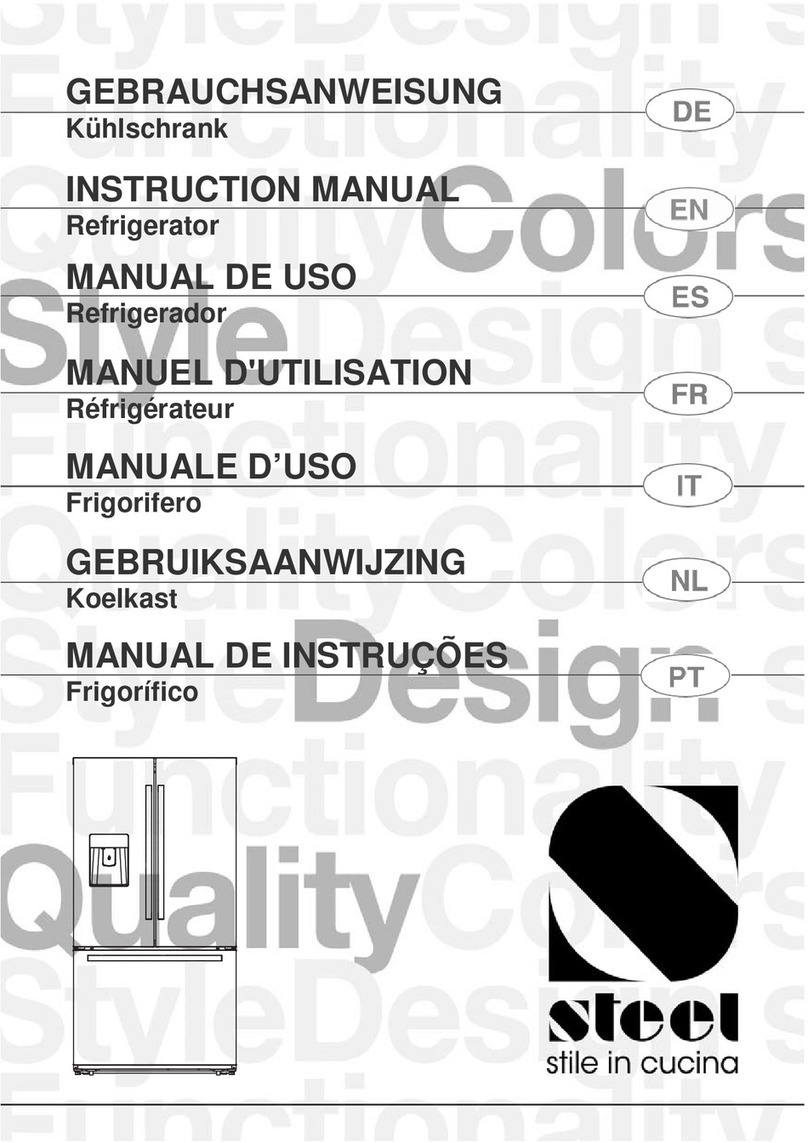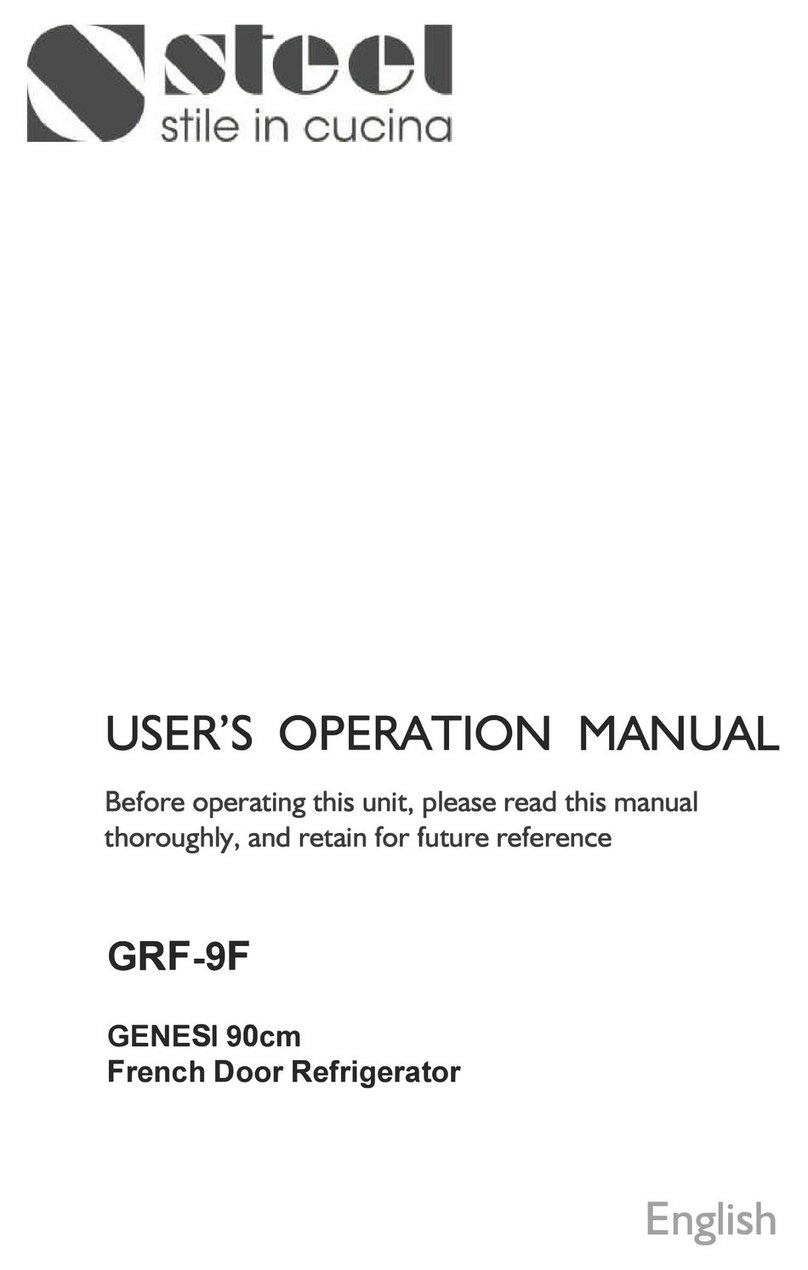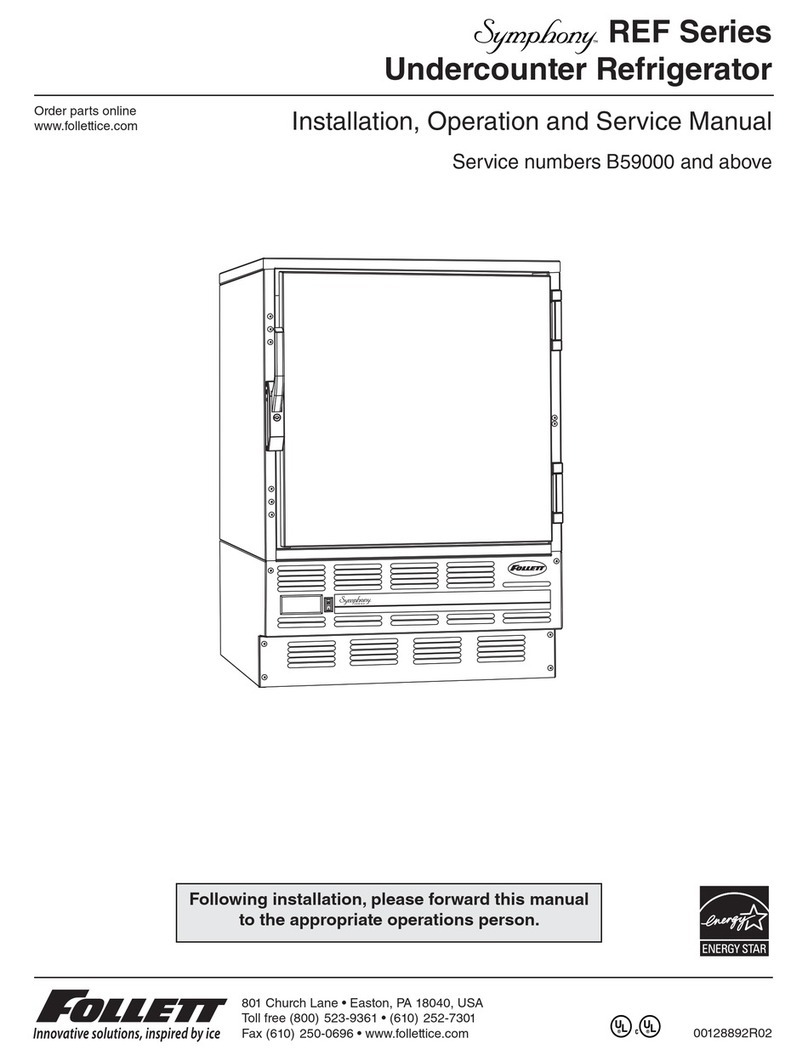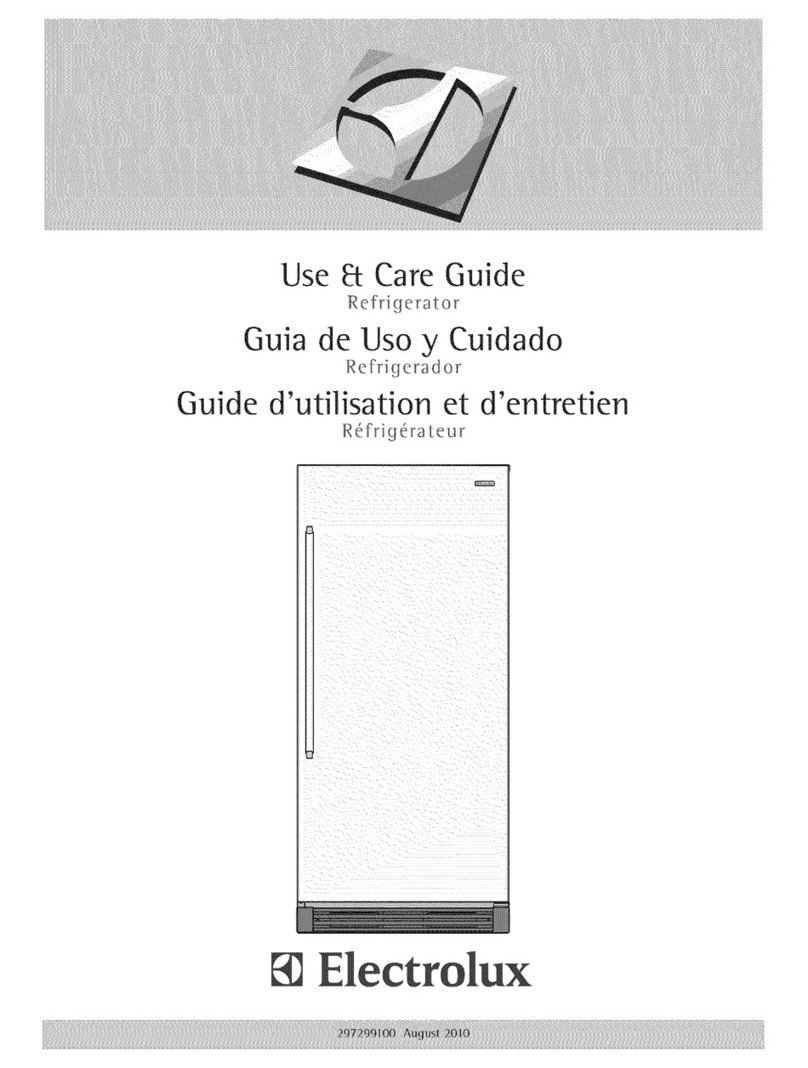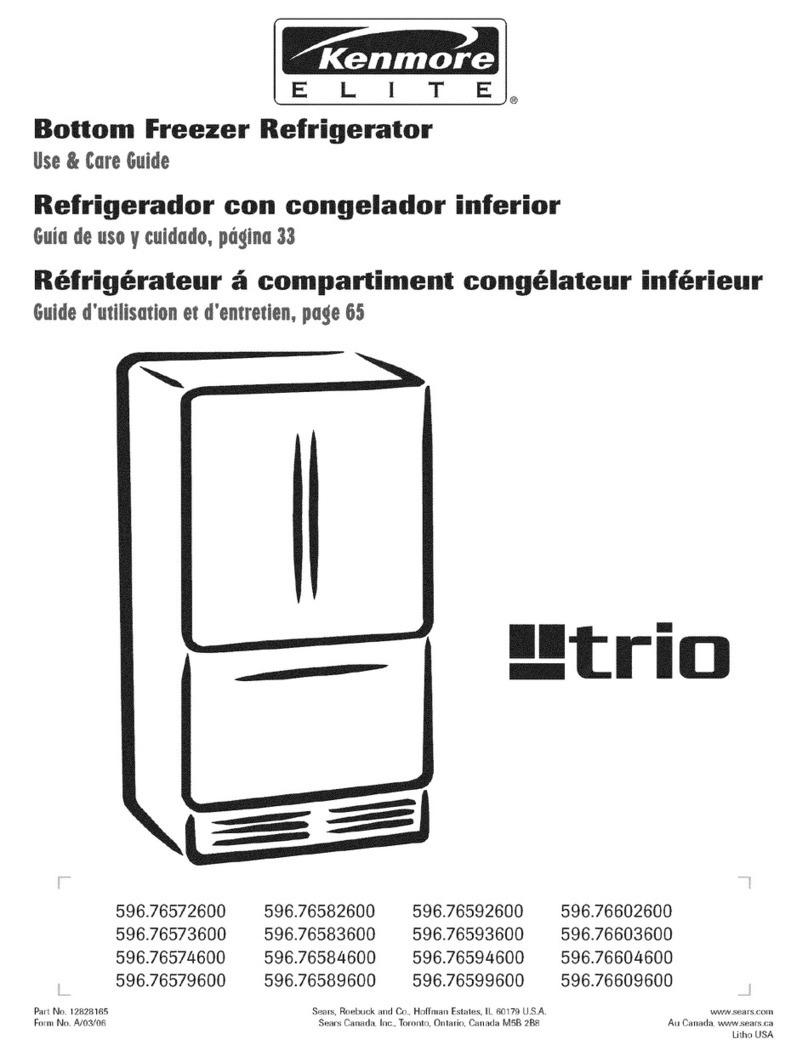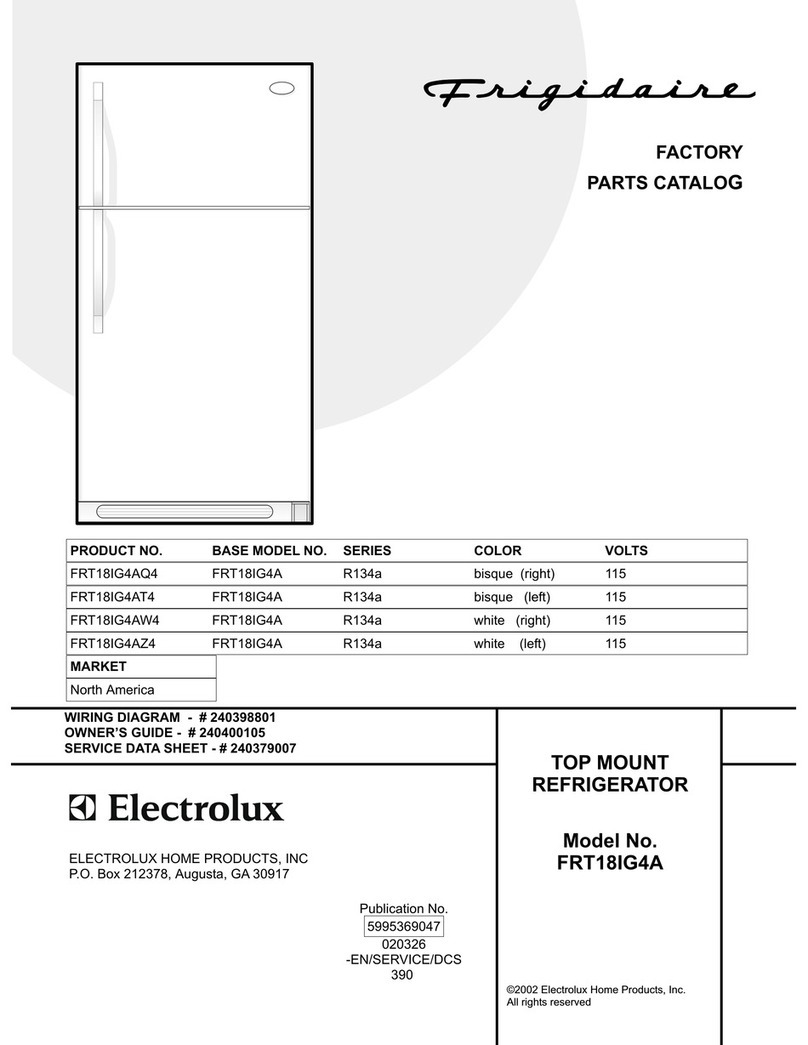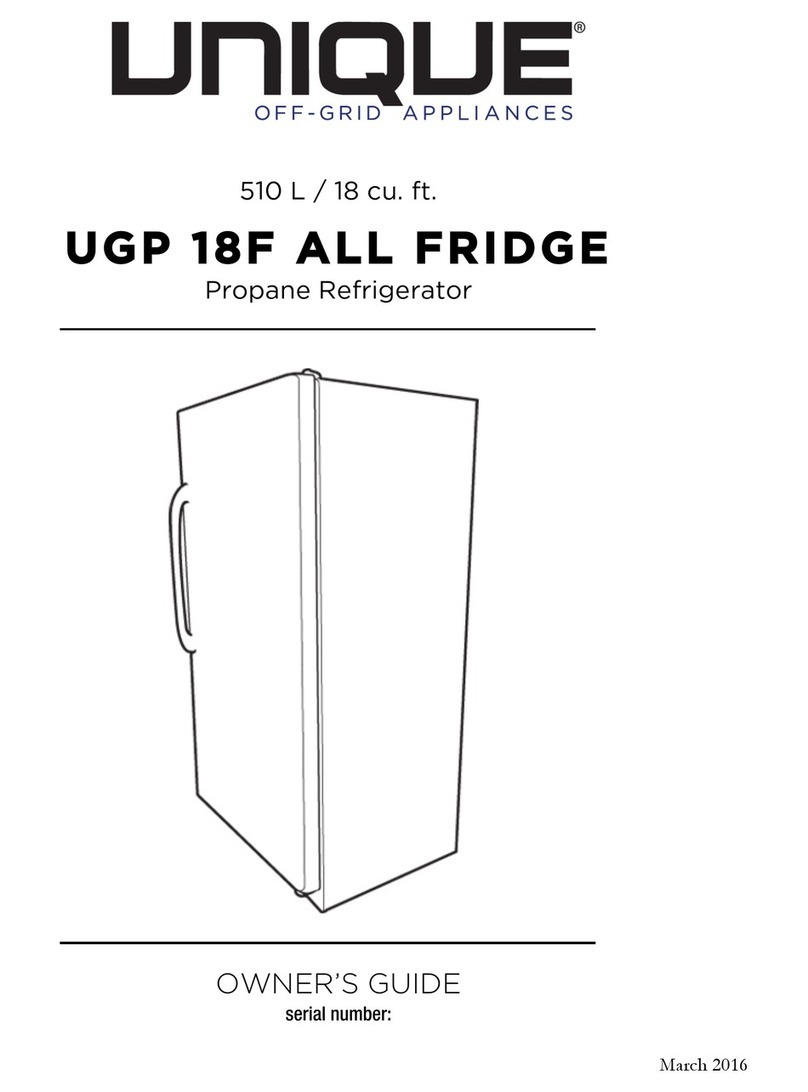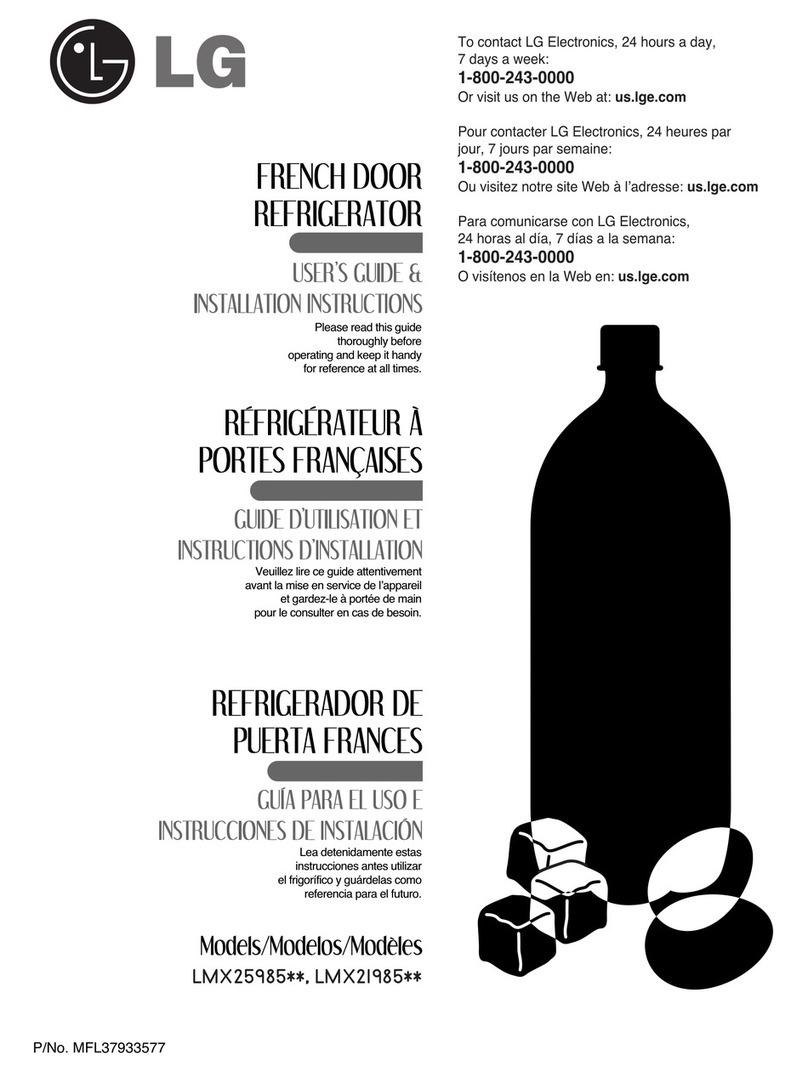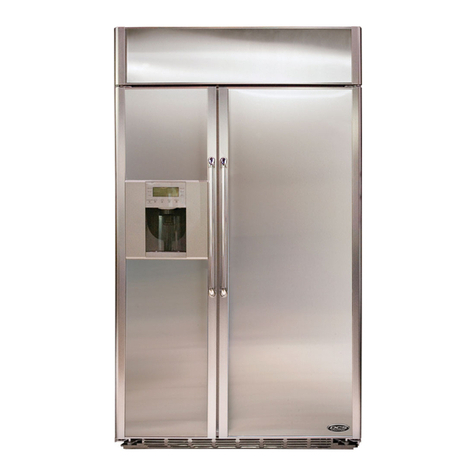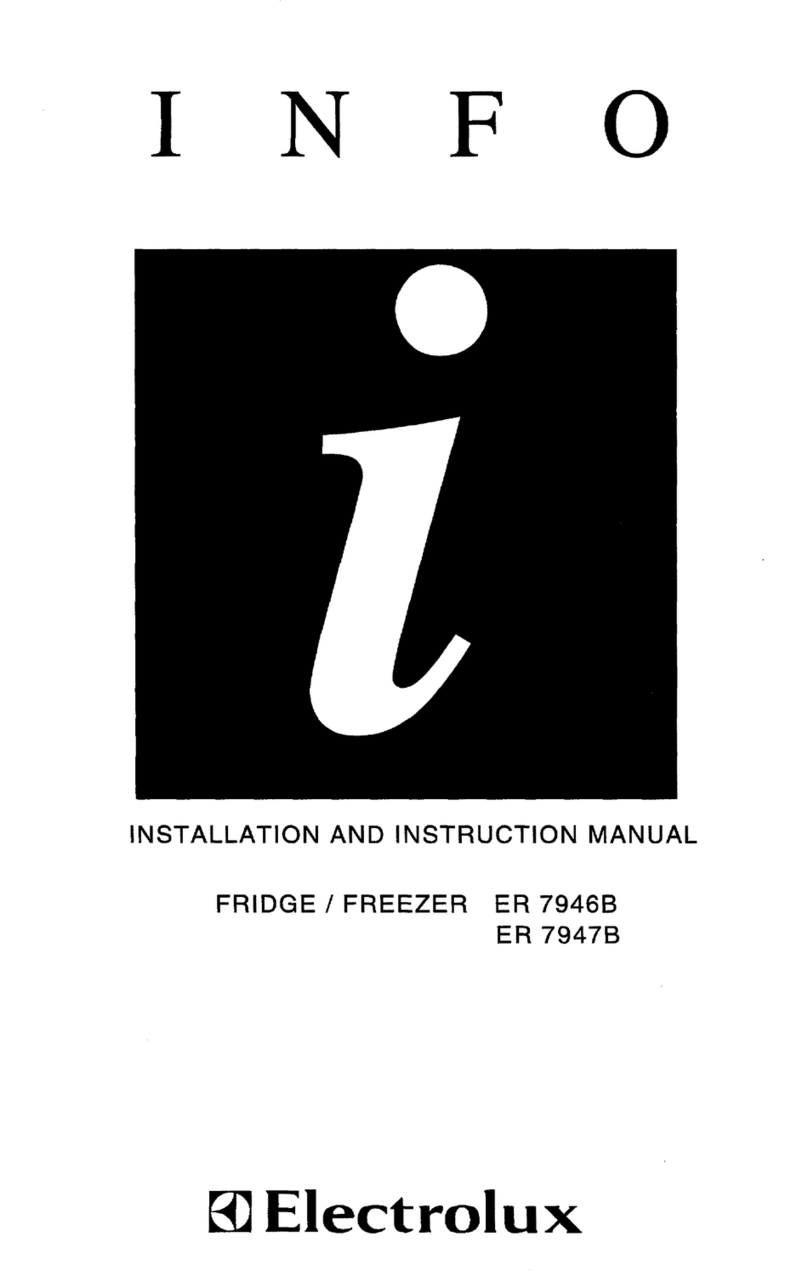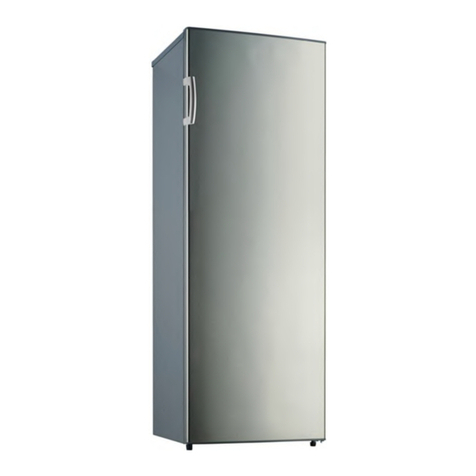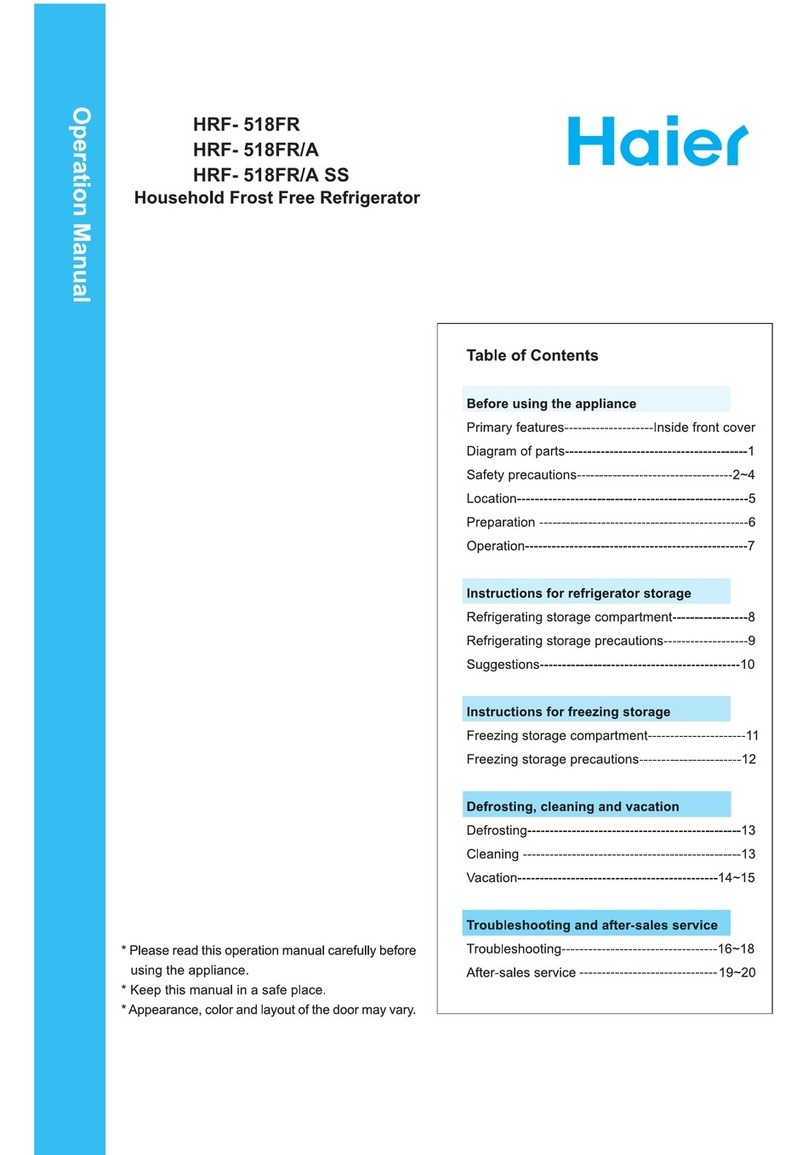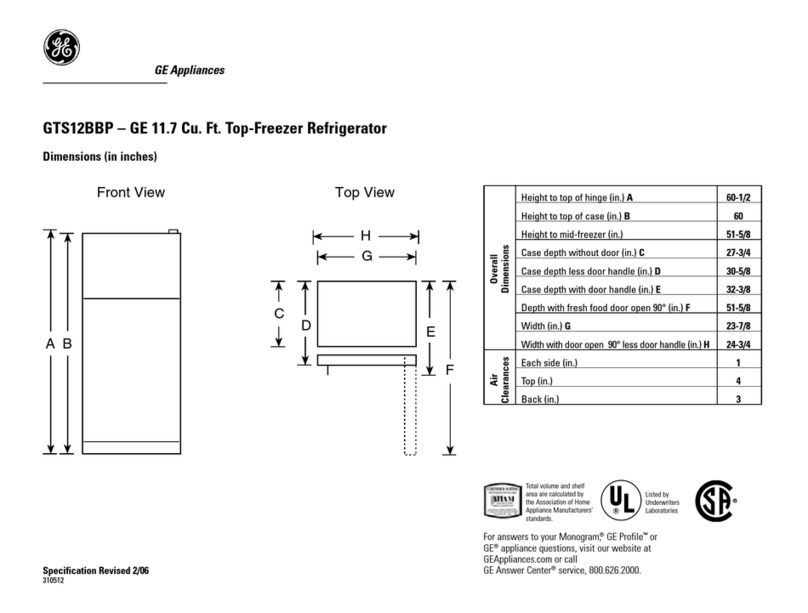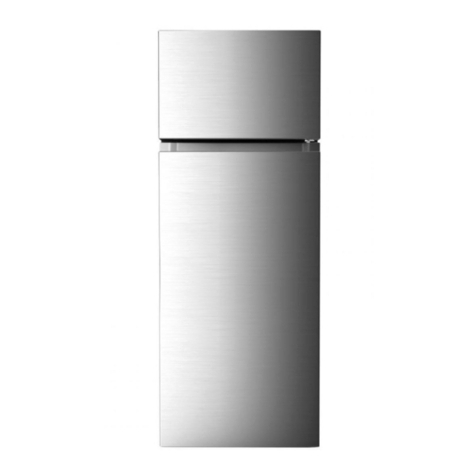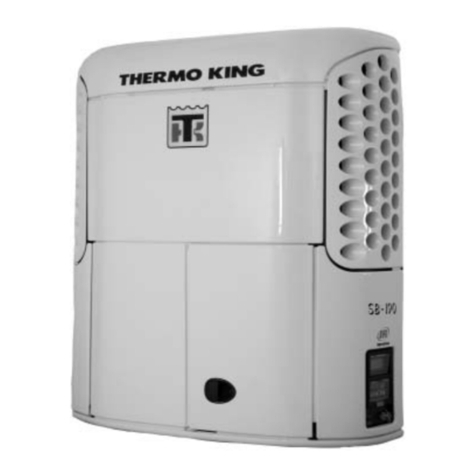steel AFR-9-SS User manual

MANUALE D’USO
Frigorifero
GEBRAUCHSANWEISUNG
Kühlschrank
GEBRUIKSAANWIJZING
Koelkast
MANUEL D'UTILISATION
Réfrigérateur
INSTRUCTION MANUAL
Refrigerator


ENGLISH
1-18
FRANÇAIS 20-35
NEDERLANDS
38-53
DEUTSCH 56-74
ITALIANO 76-92

Disposal of Used Electrical &
Electronic Equipment
The meaning of the symbol on the product,
its accessory or packaging indicates that this
product shall not be treated as household
waste. Please, dispose of this equipment at
your applicable collection point for the recycling
of electrical & electronic equipments waste.
In the European Union and Other European countries
there are separate collection systems for used electrical
and electronic product. By ensuring the correct disposal
of this product, you will help prevent potential hazards
to the environment and to human health, which could
otherwise be caused by unsuitable waste handling
of this product. The recycling of materials will help
conserve natural resources.
Please do not therefore dispose of your old electrical
and electronic equipment with your household waste.
For more detailed information about recycling of this
product, please contact your local city office, your
household waste disposal service or the shop where you
purchased the product.
SAFETY WARNING
This appliance contains a certain amount of
isobutane refrigerant (R600a) a natural gas
with high environmental compatibility that is,
however, also combustible.
When transporting and installing the appliance,
care should be taken to ensure that no parts of the
refrigerating circuit are damaged.
Refrigerant squirting out of the pipes could ignite
or cause eye injury. If a leak is detected, avoid any
naked flames or potential sources of ignition and air
the room in which appliance is standing for several
minutes.
·In order to avoid the creation of a flammable gas-air
mixture if a leak in the refrigerating circuit occurs, the
size of the room in which the appliance may be sited
depends on the amount of refrigerant used.
The room must be 1 m³ in size for every 8g of
R600a refrigrant inside the appliance. The amount of
refrigerant is shown on the identification plate inside
the appliance.
·Never start up an appliance showing any signs of
damage. lf in doubt, consult your dealer.
Refrigerant Information
(R-134a Models Only)
Refrigerant R-134a
Charge 0.190kg
Global Warming Potential 1300
Contains fluorinated greenhouse gases covered by the
Kyoto Protocol and is hermetically sealed.
Foam blown with fluorinated greenhouse gases.
Blowing Agent C-pentane
Observe Ambient Temperature
This refrigerator is designed to operate in ambient
temperature specified by its category, which is marked
on the rating plate
Climatic category Ambient temperature from...to
SN + 10°C to + 32°C
N+ 16°C to + 32°C
ST + 16°C to + 38°C
T+ 16°C to + 43°C
NOTE
Internal temperature may be affected by such factors as
the location of the refrigerator, ambient temperature and
frequency of the door opening.
Contents
Be sure to keep for safety! ······································ 1~2
Installation guide ························································· 3
Control panel ······························································ 4
Temperature control ··················································· 5
How to use the interior parts ·································· 6~7
How to use the dispenser ··········································· 8
How to use the automatic ice maker ··························· 8
Care & cleaning ···················································· 9~10
Before you call for service.. ······································ 11
Something strange?
Don’t worry. Here is the answer. ······························· 12
Installation preparation ············································· 13
If the refrigerator can not pass through a door
during installation, follow these steps. ················ 14~15
Refrigerator Leveling & Door Adjustment
(If needed) ······························································· 16
How to install Water Line ···································· 17~18

1
Be sure to keep for safety!
Read these safety instructions thoroughly and
✽carefully before using. Please keep this user guide on
hand for future reference.
Indicates the possibility of danger of
death or serious injury.
Indicates the possibility of risk of personal
injury or material damage.
Other Signs
DO NOT remove or disassemble!
Be sure to unplug from outlet/mains!
NO. DO NOT...
Be sure to keep and follow!
Caution
If the supply cord becomes damaged, it1.
must be replaced by a qualified person in order to
avoid a hazard.
This appliance is not intended for use by persons2.
(including children) with reduced physical, sensory
or mental capabilities, or lack of experience and
knowledge, unless they have been given supervision
or instruction concerning use of the appliance by a
person responsible for their safety.
WARNING
WARNING
CAUTION
Never let the power cord be crushed by the
refrigerator itself or other (heavy) objects.
Never bend power cord excessively.
If the cord is damaged or peeled, it can be a
●cause of fire and electric shock.
Do not plug several appliances into the same
wall outlet.
It can be a cause of overheating and/or fire.
●Use an exclusive grounding receptacle for the
refrigerator.
Never hold the power cord or plug with wet
hands.
There is a risk of electric shock.
●Never use a damaged power cord or plug, or
loose main socket.
There is a risk of fire, electric shock or serious
●injury.
Be sure to ground. Check if your wall outlet is
grounded (earthed).
There is a risk of electric shock hazards.
●Never unplug by pulling only the power cord
wire. Always grip the plug firmly.
Let the cord from the plug outlet be directed
downwards.
If it is directed up, the cord near the plug is
●bent and can be damaged, which can cause
an electric shock or fire.
Do not install the refrigerator on a wet floor
or in a place with excessive humidity and
moisture.
Electric insulation gets weakened, resulting in
●a risk of electric shock hazards.
Never let the power cord touch or pass over
heating appliances.
Power cord can be damaged, resulting in a risk
●of electric shock hazards.
Check if plug is loose from the wall outlet.
Electric insulation gets weakened, resulting in
●a risk of electric shock hazards.
Never pour or spray water into the refrigerator
(both interior and exterior).
Electric insulation gets weakened, resulting in
●a risk of electric shock hazards.
Do not place containers with water or liquid
on top of refrigerator.
Water can spill into the refrigerator and can
●cause electric shock hazards or damage.
Do not let children hang on the refrigerator
doors.
Refrigerator can fall and harm them.
●Do not move or remove compartment shelves/
pockets while foods and containers are on
them.
Hard containers (of glass, metal etc.) can fall to
●hurt you and can break glass shelf and interior
parts.

2
Never repair or disassemble or amend the
refrigerator on your own.
There is a risk of personal injury or damage
●to the refrigerator. It is recommended that any
service be carried out by a qualified person.
Never store any flammable gas or liquid in the
refrigerator.
Never use flammable gas, benzene, thinners,
gasoline, spray etc. near the refrigerator.
There is a risk of fire, explosion and personal
●injury or damage.
If a gas leak is found near the refrigerator or
in the kitchen, ventilate it immediately without
touching the power plug or refrigerator.
Do not store medicine or academic research
samples which require strict temperature
control in the refrigerator.
Never insert fingers or hands into the bottom
of the refrigerator, especially into the bottom
at the back.
You can be hurt by sharp metal edges or can
●receive an electric shock.
Do not change fuse or light bulb on your own.
Call the service agent to change them.
When you find the power cord damaged or
cut, call the service agent immediately.
When you get rid of your old refrigerator, be
sure to remove the doors first.
Children can be entrapped and suffocated in
●an abandoned refrigerator.
Keep ventilation openings, in the appliance
enclosure or in the built-in structure, clear of
obstruction.
Do not use mechanical devices or other
means to accelerate the defrosting process.
Do not use electrical appliances inside the
food storage compartments of the appliance.
The ice-maker in the freezer can be only
replaced by the manufacturer or the service
agent.
When the freezer door is open, do not press
the dispenser lever.
Connect to drinkable water supply only.
Be sure to unplug the refrigerator when it is
not going to be used for a long time.
Never touch foods and containers especially
of metal with wet hands in the freezer
compartment.
You can be hurt by chilblains or cold burns.
●Never eat any decayed or deteriorated food at
all.
Foods stored too long in the refrigerator can
●deteriorate and become decayed.
Never place bottles and containers of glass in
the freezer compartment.
Glass containers and bottles can break and
●can hurt you.
When moving the refrigerator (horizontally or
tilted), more than 2 people are required to hold
it. (One to hold top back handles, the other to
hold the bottom holder.)
If other parts are held instead, it is very
dangerous and likely to slip.
Be sure to turn up the wheel first before
moving the refrigerator.
The wheels can damage or scratch the floor.
●If you are moving it for a long distance, never
forget to fasten the interior parts tightly with
tapes. Otherwise, the parts can collide and
break each other.
CAUTION

3
Installation Guide
Read these safety instructions carefully before use
✽and follow precautions for your safety.
Precautions in installation and
power connection
■ To prevent fire, electric shock or leakage.
❶Never install the refrigerator on a wet, watery floor
or where water can gather easily.
❷Check the following before power connection.
Connect power plug only to a grounded wall socket
●(an earthed mains).
Do not plug refrigerator power together with other
●appliances to the same socket.
❸Do not use an adapter plug or an extension cord.
❹Do not let the power cord be crushed by other
(heavy) objects.
If you hear a strange noise, strong chemical odour
●or find smoke etc. from the refrigerator after the
power is plugged in, pull out the plug immediately
and call a service agent.
Wait about 5 minutes before you plug-in again in
●order to prevent any damage to the compressor
and electrical devices of the refrigerator.
Wait 2~3 hours until the inside gets cold enough
●after the first power plug-in, then store foods inside.
(There can be some smell of plastic parts on initial
operation of the refrigerator after plugging in. The
smell fades away as the refrigerator works and
doors are opened and closed.)
Precautions in use
■ To prevent personal injury, fire, electric shock etc.
read this user guide carefully before use and keep it
at hand for reference.
■ Accessories
Egg bin
Filter box Water supply kit User guide manual
Dispenser Models Only

Control Panel
Dispenser Model
■
FRZ.SET button
Temperature selection button for freezer
compartment.
LIGHT/FILTER button
1) Button for dispenser light on.
2) Button for filter exchange or reset.
After exchanging or to reset, press the button
for 3 seconds.
Filter exchange display
After 6 months of first power input, the icon will
flicker.
Button for water dispensing.
Water symbol lights up when selected.
Selection button for ice dispensing and lock
for ice maker.
REF.SET button
Temperature selection button for refrigerator
compartment.
Lock button for control panel
Press button for more than 3 seconds to activate
and prevent settings from being unintentionally
changed.
To unlock, press for more than 3 seconds. The
display goes out.
Basic Model
■
FRZ.SET button
Temperature selection button for freezer
compartment.
REF.SET button
Temperature selection button for refrigerator
compartment.
Lock button for control panel
Press button for more than 3 seconds to activate
and prevent settings from being unintentionally
changed.
To unlock, press for more than 3 seconds. The
display goes out.
Interior lights of the refrigerator turn off when the doors are open for more than 10 minutes.•
In case either the freezer or refrigerator door is left open for more than a minute, door alarm rings for 5•
minutes with 1 minute intervals.
Display off function•
5 minutes after no buttons or doors are operated by customer, all the display LED except for water, ice-
and ice lock icon go out.
Normal display mode resumes when customers operate buttons or doors.-
System off function (power off function)•
You can stop operating the appliance without unplugging, especially on holidays.-
Pressing-FRZ.SET and REF.SET button at the same time for 5 seconds will turn the appliance off.
Under the ‘off’ mode, freezer and refrigerator temperature displays “-- --”.-
Other LED lights go out and all the operation of your appliance halts.-
Conversely, pressing-FRZ.SET and REF.SET button together for 5 seconds will switch it back on.
Note
4

5
Temperature Control
When this refrigerator is first plugged in, the
✽temperature mode is set to [Middle].
Dispenser Model
■
Freezer Compartment
Push the FRZ.SET button and the setting temperature
changes as the figure shows.
>>> Sequential Temperature Change <<<
Faster Freezing...
When you want faster freezing, push the FRZ.SET
button until LED ' ' turns on. Just push the button
again to release.
Refrigerator Compartment
Push the REF.SET button and the setting temperature
changes as the figure shows.
>>> Sequential Temperature Change <<<
Faster Cooling or Refrigeration
When you want faster cooling or refrigeration, push the
REF.SET button until LED ' ' turns on. Just push the
button again to release.
Temperature indicator convert function
(Fahrenheit ↔Celsius)
Press the lock button to enter locked mode.
Under the locked mode, press the light and
water button at the same time for 10 sec to
swap temperature scale (default setting is
Celsius).
Basic Models
■
Freezer Compartment
Push the FRZ. SET button and the setting temperature
changes as the figure shows.
>>> Sequential Temperature Change <<<
Faster Freezing...
When you want faster freezing, push the FRZ.SET
button until LED ' ' turns on. Just push the button
again to release.
Refrigerator Compartment
Push the REF. SET button and the setting temperature
changes as the figure shows.
>>> Sequential Temperature Change <<<
Faster Cooling or Refrigeration
When you want faster cooling or refrigeration, push the
REF.SET button until LED ' ' turns on. Just push the
button again to release.
Caution
Foods in the refrigerator can be frozen if the ambient
temperature of the refrigerator is below 5°C.
Note

6
How to use the interior parts
Basic Model Interior Parts
■Dispenser Model Interior Parts
■
This instruction manual refers to several models. The real features are model dependent.
✽Door storage compartment1.
for short-term storage of food
and ice cream.
Door storage compartment2.
for storing frozen food.
Freezer shelf3.
for storing frozen foods such as
meat, fish, ice-cream.
Ice cube tray (not all models)4.
Freezer case5.
for storing dried foods, fish or
meat for long periods of time.
Ice maker & storage6.
Xpress Can Chiller7.
for storing beverage (quick
cooling compartment).
Refrigerator shelf8.
for storing common foods.
Vegetable case9.
Fruit case10.
Refreshment pocket11.
for storing refrigerating foods,
milk, juice, beer bottle etc.
Caution
Do not touch or hold with wet hands foods (foods container) in the freezer compartment.•
There is a risk of chilblains (cold burn)
✽Do not store medicine, academic research samples etc. in the refrigerator.•
Do not store vegetables in the chilled room, for they can be frozen.•
12. Egg bin
3.

7
Food Storage Tips
Wash foods before storing.
Divide and separate foods into smaller
pieces.
Place watery foods or foods with a lot of
moisture in front shelves (close to door
side).
If they are placed close to the cold air
spout, they can be frozen.
Warm or hot foods should be cooled
down enough before storing to reduce
power consumption and to enhance
refrigeration performance.
Be careful in storing tropical fruits such
as bananas, pineapples and tomatos,
as they can easily deteriorate in lower
temperatures.
Keep enough space between foods. If too
tight or too close, cold air circulation is
hindered, resulting in poor refrigeration.
Never forget to cover or wrap foods to
prevent odours.

8
How to use the Dispenser
(For Dispenser models)
Select the 'WATER' or 'ICE' button and push the lever
✽gently with your cup.
Your selection will come out 1~2 seconds later.
✽Press the 'WATER' button and icon lights up.
Press the 'ICE' button and icon lights up.
WATER CUBED ICE
When cleaning the icecubes case assembly or if
you will not use it for a long time, remove the
icecubes in the ice storage case and lock the
icemaker by pushing the 'ICE' button for 3
seconds.
Caution
Avoid using thin fragile cups or crystal glasses when•
taking icecubes.
For your safety, never insert your fingers or other tools•
into the dispenser outlet.
If you find the icecubes are discolored, stop using the•
dispenser and call a service agent.
How to use the Automatic
Icemaker (For Dispenser
models)
About 10 icecubes (14~15 times a day) are made
●at one time. If the ice storage case is full, icemaking
stops.
It is normal for the icemaker to make banging sounds
●when the icecubes are falling into the ice storage
case.
To prevent bad odours or smells, regularly clean the
●icecubes storage case.
If the amount of ice in the storage case is not
●sufficient, the ice may not be dispensed. Wait a day
or so to make more ice.
If the ice does not dispense easily, ensure the
●dispenser outlet is not blocked.
In case the icemaker doesn’t work
If the icecubes get stuck and not dispensed
Pull out the ice storage case and separate any
●icecubes that may have stuck together.
If the amount of water which is supplied to the
●icemaker needs adjusting, call for a service agent.
In case of power failure
The icecubes in the case may melt and flow to the
●room.
If many hours of power failure is predicted, pull out
●the case, remove the icecubes in it and replace it
back when power resumes.
Use only the ices out of this refrigerator.
Note

9
Care & Cleaning
❶Dispenser Water Shelf
Remove the spill grill and clean the water shelf•
regularly. (The spill shelf is not self-draining.)
❷Freezer & Refrigerator Pockets
Hold both ends and pull up.•❸Icecubes storage Case
Removing: Pull the case assembly forward to•
remove.
Replacing: Fit to the side grooves and insert to the•
end. If it is difficult to fully insert the case, remove it,
rotate the swirl coil in the case or drive mechanism
a quarter turn and insert again.
* Do not store the icecubes for too long.
Be sure to
unplug first !
The real features are model dependent
✽Never use any other electrical appliances together in the inside of the refrigerator for fear of electric shock
or fire.
Note
❶❷❷❸❹❹❺❺

10
❹Freezer & Refrigerator Shelves
Open the doors fully, then pull the shelves forward•
to remove.
❺Vegetable Case & Fruit Case
Pull forward and lift up a little to remove.•
Caution
Be careful not to hurt your hands and fingers when•
cleaning the assembly.
How to Clean
Interior Parts
Use cloth with water and mild detergent to clean.•
Back (Machine section)
Remove dust on grill with a vacuum cleaner at least•
once a year.
Caution
Never use petrol, benzene,•
thinners, scouring pads or harsh
abrasives, for they can damage the
surfaces.

11
Before You Call for
Service...
Please check the following troubleshooting tips before
✽you call for service!
Problem
It never gets cold inside.
Freezing & refrigerating is not
very good.
Checkup Point
❶ Is the refrigerator unplugged?
❷ Is the temperature set to [Low Mode]?
❸ Is the refrigerator under direct sunlight or is a heat
appliance placed near it?
❹ Is the space between the refrigerator back and the
wall too close?
Action
❶Plug in the refrigerator.
❷Set the temperature mode to Middle or High.
❸Move to a place where there is no direct sunlight, no
heat appliances around.
❹Keep sufficient space between the back of the
refrigerator and the wall.
Problem
Foods in the refrigerator get
frozen.
Checkup Point
❶Is temperature set to [High]?
❷Is the room temperature too low?
❸Is food with moisture stored close to the cold air
spout ?
Action
❶Set the temperature to [Middle] or [Low].
❷Foods can be frozen if ambient temperature is below
5℃. Move to a place where the temperature is over
5℃.
❸ Place foods with moisture on the shelves close to the
doors.
Problem
Strange sounds from the
refrigerator.
Checkup Point
❶ Is the floor beneath the refrigerator uneven?
❷ Is the space between the refrigerator back and the
wall too close?
❸ Does any object touch the refrigerator?
Action
❶Move the refrigerator to a level and even floor.
❷ Keep sufficient space.
❸ Remove any object which touches the refrigerator.
Problem
Odour or unpleasant smell from
the inside.
Checkup Point
❶ Is the food stored uncovered or unwrapped?
❷ Are the shelves and pockets stained with food stuff?
❸ Is the food stored too long?
Action
❶Be sure to cover and wrap the foods.
❷ Clean them regularly. Once smell gets soaked into
those parts, it is not easy to remove.
❸ Do not store foods for too long. A refrigerator is
neither a perfect nor a permanent food keeper.

12
Something strange?
Don’t worry. Here is the answer.
Case Explanation
Heat Front and side of refrigerator
feels warm or hot.
Pipes (refrigerant vessel) are placed beneath•
the surface to prevent moisture forming on it.
Door is
sticky Doors do not open easily.
When you close the door and then open it•
again immediately, the door is not easy to
open. Warm air rushes into the inside to
create the pressure difference. In this case
wait for a minute, it will then open easily.
Strange
Sound
It sounds like water is flowing
from the refrigerator.
When the compressor starts to run or stops,•
refrigerant which makes the inside cold
flowing in the pipes can make such sound.
Defrosted water can also make such sound.•
(This refrigerator adopts an automatic
defrosting system.)
Cracking or clicking sounds.
Inside parts shrink and/or expand due to•
temperature change --- When the inside gets
cold or when the door is open, such sounds
can be made.
Humming or buzzing sounds.
Compressor or fans for cold air circulation can•
make such working sound. (If the refrigerator
is not level, the sound can be louder.)
Frost &
Dew
Dew or frost on the wall and/
or food container surface in
the freezer and refrigerator
compartment.
Frost and/or dew can be made in the following
cases;
High temperature and/or high humidity around•
the refrigerator.
When doors are open too long.•
Foods with much moisture are stored•
uncovered or unwrapped.
* You can see the same appearance when
cold water is poured in a glass cup and dew is
forming on the surface of it.
Dew on the cabinet surface.
If it is highly humid around the refrigerator,•
moisture in the air sticks to the surface to
form dew.

13
Installation Preparation
Check if the refrigerator can pass a
doorway or enter a door first.
Dimensions (including Door Handles)
Find a suitable place to install
Ensure sufficient space from the back of refrigerator to
the wall for free air ventilation.
Avoid direct sunlight.
Once the installation place is ready, follow
the installation instructions.
If the surrounding temperature of the
refrigerator is low (below 5°C), foods can
be frozen or the refrigerator can function
abnormally.
Note
More than 5cm
More than 5cm
(Width*Depth*Height) 916mm x 750mm x 1980mm
80 mm 80 mm
mm0411
mm014
mm
00
01
mm455
mm0017
347 mm
mm
0
56
50 mm
50 mm
50 mm
50 mm
mm054

14
If the refrigerator can not
pass through a door during
installation, follow these
steps.
(This guide refers to several models. The real features
are model dependent.)
Removing Refrigerator Door
Remove front bottom cover first, if it is attached.
✽1 Unscrew top hinge cover with a screwdriver. Insert
a thin screwdriver into the side groove of the cover
to remove.
2 Turn top hinge fastener counterclockwise
3~4 times. Disconnect harness wires (model
dependent).
3 Lift up the front of hinge to remove. (After the hinge
is removed the door can fall down forward.
Be careful !)
4 Lift the door straight up to remove.
Removing Freezer Door
1 Pull out bending tube guide and the left water tube.
(Dispenser Models Only)
2 Unscrew top hinge cover with a screw driver.
3 Turn top hinge fastener counterclockwise 3~4
times. Disconnect the harness wires.
4 Lift up the front of hinge to remove. (After the hinge
is removed the door can fall down forward.
Be careful !)
5 Be careful not to damage the water line when
removing the door.

15
Replacing Refrigerator Door
1 Insert the bottom hole of the refrigerator door
straight into the bottom hinge pin.
2 Let the top of the door close and insert the top
hinge pin to the top hole of the refrigerator door.
(Insert the back of hinge to the groove of protrusion
first, then front to the top hole of door.)
3 Turn the hinge fastener tightly to the end. Connect
harness wirings (model dependent) and screw
down the ground wire. Click and screw the top
hinge cover.
Replacing Freezer Door
1 Insert the water tube into the hole of the bottom
hinge pin first(Dispenser Models Only). Insert the
bottom of freezer door into the bottom hinge pin.
2 Let the top of the door close and insert the top
hinge pin to the top hole of the freezer door. (Insert
the back of hinge to the groove of protrusion first,
then front to the top hole of door.)
3 Turn the hinge fastener tightly to the end. Connect
harness wirings and screw ground wire.
4 Click and screw the top hinge cover
5 Fasten the bending tube guide and insert the water
tube far into the coupling. (Dispenser Models Only)

16
Refrigerator Leveling &
Door Adjustment (If needed)
The refrigerator must be level in order to maintain
✽optimal performance and desirable front appearance.
(If the floor beneath the refrigerator is uneven, the
freezer and refrigerator doors may look unbalanced.)
In case freezer door is lower than
refrigerator door...
1 Insert a screw driver (flat tip) into a groove of the
left wheel (bottom of freezer) and turn it clockwise
until the door is balanced. (Clockwise to raise
freezer door, counterclockwise to lower.)
If the freezer door is not balanced by step 1, then
✽follow the next steps.
2 Open the doors, unscrew the front cover and
remove, if it is attached.)
3 Insert a spanner (part A) into the hinge nut (part 1)
and unscrew the nut by turning clockwise.
4 Insert a spanner (part B) into the hinge nut (part 2)
and turn clockwise to lower the door.
5 If the door is aligned, fasten the nut (part 1) tightly
by turning counter-clockwise.
In case refrigerator door is lower
than freezer door...
1 Insert a screw driver (flat tip) into a groove of the
right wheel (bottom of refrigerator) and turn it
clockwise until the door is balanced. (Clockwise to
raise refrigerator door, counterclockwise to lower.)
If the freezer door is not balanced by step 1, then
✽follow the next steps.
2 Insert a spanner (A part) into the hinge nut (1 part)
and unscrew the nut by turning clockwise.
3 Insert a spanner (B part) into the hinge nut (2 part)
and turn counter-clockwise to tighten the door.
4 If the door is aligned, fasten the nut (1) tightly by
turning.
Front Cover
■
After installation and/or door leveling, fasten front cover
with screws. (Remove the screws on the front bottom
panel first. Click and screw the cover.)
Caution
The front of the refrigerator needs to be just a little•
higher than the back for easy door closing, but if the
wheel is raised too much for door balance, i.e. the
front of refrigerator is much higher than the back, it
can be difficult to open the door.
This manual suits for next models
3
Table of contents
Languages:
Other steel Refrigerator manuals
